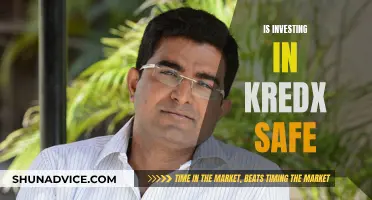
Medium-risk investments offer a balanced approach to investing, falling between low-risk and high-risk assets. They are less stable than low-risk investments but offer higher returns. Medium-risk investments include dividend-paying stocks, corporate bonds, and peer-to-peer lending.
| Characteristics | Values |
|---|---|
| Return | Medium-risk investments have the potential to provide impressive returns, higher than low-risk investments but lower than high-risk investments |
| Volatility | Medium-risk investments are less volatile than high-risk investments but more volatile than low-risk investments |
| Stability | Medium-risk investments are less stable than low-risk investments but more stable than high-risk investments |
| Growth | Medium-risk investments offer more growth than low-risk investments but less growth than high-risk investments |
| Examples | Corporate bonds, preferred stocks, dividend-paying common stocks, funds, peer-to-peer lending |
What You'll Learn
- Medium-risk investments offer a balanced approach, falling between low-risk and high-risk assets
- Medium-risk investments can provide impressive returns, but with slightly higher uncertainty
- Corporate bonds offer a fixed rate of return and are often considered a moderate-risk investment
- Preferred stocks are shares of a company that offer shareholders priority over common stockholders regarding dividend payments
- Dividend-paying stocks are considered a more stable option and can be a great way to earn monthly income

Medium-risk investments offer a balanced approach, falling between low-risk and high-risk assets
Examples of medium-risk investments include dividend-paying stocks, corporate bonds, and peer-to-peer lending. Dividend-paying stocks are shares of companies that distribute a portion of their profits to shareholders in the form of dividends. This can be a great way to earn monthly income and is considered a more stable option. Corporate bonds offer a fixed rate of return, and holding bonds from a high-quality company until they mature is often considered a medium-risk investment. Peer-to-peer lending has also gained popularity in recent years as a medium-risk investment option.
Funds offer exposure to multiple assets in a single investment and are another example of a medium-risk investment. Exchange-traded funds, index funds, and mutual funds fall into this category. These funds provide access to a diversified portfolio, reducing the overall risk compared to investing in individual stocks.
When considering medium-risk investments, it is important to remember that they may not offer the same level of stability as low-risk investments. However, they provide the potential for higher returns than low-risk options. Therefore, medium-risk investments are suitable for those willing to take on slightly higher risk in exchange for potentially higher returns.
Smart Investing Guide: 5 Lakhs in India
You may want to see also

Medium-risk investments can provide impressive returns, but with slightly higher uncertainty
Medium-risk investments are a balanced approach to investing, falling between low-risk and high-risk assets. They are ideal for those seeking a combination of stability and growth. Medium-risk investments can provide impressive returns, but they come with slightly higher uncertainty than low-risk investments.
While they may not offer the same stability as low-risk investments like CDs or high-yield savings, medium-risk investments have the potential to earn a higher average rate of return. This makes them an attractive option for those willing to take on a little more risk.
There are several types of medium-risk investments to consider. Corporate bonds, for example, offer a fixed rate of return and are often considered a moderate-risk investment. Holding bonds from a high-quality company until they mature can provide a steady income stream. Preferred stocks are another option, offering shareholders priority over common stock holders when it comes to dividend payments.
Dividend-paying stocks are also considered a medium-risk investment. These are shares of companies that distribute a portion of their profits to shareholders in the form of dividends, providing a regular cash flow. Peer-to-peer lending has also gained popularity in recent years as a medium-risk investment option.
Overall, medium-risk investments can provide impressive returns, but it's important to remember that they come with slightly higher uncertainty than low-risk investments. They are a balanced option for those seeking a combination of stability and growth in their investment portfolio.
Understanding Unrealized Equity Gains and Losses
You may want to see also

Corporate bonds offer a fixed rate of return and are often considered a moderate-risk investment
Medium-risk investments are a balanced approach to investing, falling between low-risk and higher-risk assets. They are ideal for those seeking a combination of stability and growth. Medium-risk investments include dividend-paying stocks, peer-to-peer lending, and corporate bonds.
Corporate bonds come with varying levels of risk. The risk of default is relatively low for strong, established companies but can be higher for smaller or less stable companies. As such, it is important to consider the financial health and track record of the company before investing in its bonds.
The most common form of corporate bond is a fixed-rate coupon, which has a stated coupon that remains fixed throughout the bond's life. The payment amount is calculated as a percentage of the par value, regardless of the purchase price or current market value. With corporate bonds, one bond typically represents $1,000 par value, so a 5% fixed-rate coupon will pay $50 per bond annually.
Overall, corporate bonds can be a good option for those seeking a moderate-risk investment with a fixed rate of return. By investing in bonds from high-quality companies and holding them until maturity, investors can benefit from a relatively safe investment with the potential for higher returns than low-risk alternatives.
Understanding the Risks: What to Avoid in Your Investment Portfolio
You may want to see also

Preferred stocks are shares of a company that offer shareholders priority over common stockholders regarding dividend payments
Medium-risk investments are a balanced approach to investing, falling between low-risk and higher-risk assets. They are less volatile than high-risk investments but offer more growth potential than low-risk choices. Medium-risk investments include dividend-paying stocks, which are considered a more stable option. These are shares of companies that distribute a portion of their profits to shareholders in the form of dividends.
Preferred stocks are one such example of a medium-risk investment. Preferred stocks are shares of a company that offer shareholders priority over common stockholders regarding dividend payments. This means that preferred stockholders receive dividend and asset payouts before common stockholders. In the event of a company liquidation, preferred stockholders have a priority claim on the company's assets and earnings. They are also paid any arrears before common stockholders. Preferred stockholders typically have no or limited voting rights in corporate governance.
Preferred stocks have characteristics of both bonds and common stock, which makes them appealing to certain investors. They are less volatile than common stock and are callable. Preferred stockholders usually receive a higher dividend yield than common stockholders, and these dividends can be paid monthly or quarterly. These dividends can be fixed or set in terms of a benchmark interest rate like the London Interbank Offered Rate (LIBOR).
Because preferred stockholders have priority over common stockholders in regard to dividends, any forgone dividends accumulate and must eventually be paid to preferred shareholders. Preferred dividends accumulate and must be reported in a company's financial statement.
Venture Capitalists' Investment Strategies: Key Factors for Decision-Making
You may want to see also

Dividend-paying stocks are considered a more stable option and can be a great way to earn monthly income
Medium-risk investments are a balanced approach to investing, falling between low-risk and high-risk assets. They are worth considering if you can handle slightly higher uncertainty, as they have the potential to provide impressive returns. Dividend-paying stocks are considered a more stable option and can be a great way to earn monthly income.
Dividend-paying stocks are shares of companies that distribute a portion of their profits to shareholders in the form of dividends. This can provide a more reliable income stream compared to some other investment options, as well as a hedge against inflation. They are also tax-advantaged when compared to some other forms of income.
Dividend-paying stocks can be particularly useful for investors who are looking for immediate cash flow or downside defence during market sell-offs. They may also help to lower volatility and buffer losses during market downturns. Companies that have consistently increased their dividends tend to be more stable, higher-quality businesses that are more likely to be able to pay dividends consistently.
Some examples of companies that currently offer high-quality dividend payouts include Brookfield Renewable, Enbridge, NNN REIT, T. Rowe Price, and Verizon. These companies have an excellent record of increasing their high-yielding dividends, making them great stocks to buy for lucrative and steadily rising income streams.
Strategizing Your Investment Portfolio: A Comprehensive Guide
You may want to see also
Frequently asked questions
A mid-risk investment falls between low-risk and high-risk assets, offering a balanced approach to investing.
Mid-risk investments have the potential to provide impressive returns, without the volatility of high-risk investments or the limited growth of low-risk investments.
Dividend-paying stocks, corporate bonds, and peer-to-peer lending are all considered mid-risk investments.
Mid-risk investments are worth considering if you can handle slightly higher uncertainty than low-risk investments, but don't want to take on the full volatility of high-risk investments.







